Abstract
This article presents the results of analyses of energy efficiency and environmental outcomes of putting into operation high-speed trains—first of that kind in Poland—in 2014 on upgraded 3 kV DC lines. Comparative analyses of these trains in Poland have not been carried out so far and provide a new approach to assessing the feasibility of their adoption and, in a broader context, the advisability of replacing conventional with high-speed rail transport. The analysis supports the advantages of high-speed railway (HSR) and the need to develop a network of high-speed connections using energy-efficient trains in Poland. Putting these trains into service reduced CO2 emissions, which is significant in Poland as a country relying heavily on power generated in coal power plants and complies with the assumptions of the sustainable development policies and EU Green Deal. The outcomes of our analysis can be used for transportation planning to mitigate climate change and the presented approach provides a method of quantification of environmental impacts of HS trains.
1. Introduction
Sustainable transport has been of interest to international institutions and governments for many years. The need to protect natural environment and carry out activities with a view to the well-being of present and future generations provide the basis for sustainable development. The concept of sustainable development in transport was used for the first time at the 3rd Governing Session of the United Nations Environment Program in 1975 [1]. The 1992 Earth Summit in Rio de Janeiro brought with it, among others, the official adoption by different countries a theory of sustainable development as the basis of development [2]. The Summit accepted Agenda 21, a global environmental action program [3]. The message of Agenda 21 has inspired other documents of many organizations, including the European Union, which, in May 1993, adopted the Fifth Environmental Protection Program “Towards Sustainability” [4] that initially covered the years 1993–1997, but has been further extended until 2000. Transport has been also included as a sector essential for economic development and environmental impacts. In 2001, the first sustainable development strategy was based upon [5]. Its four priority areas are: counteracting climate change, development of transport, protection of public health, and management of natural resources. It indicates, inter alia, that an environmentally friendly transport policy should promote environmentally friendly means of transport, in particular, replace road transport with rail, water, and public passenger transport [5], pp. 6, 13. The review of the implementation of this Strategy by Member States resulted in an agreement in 2006 on the Renewed Strategy [6] which defines the following crucial goals: transition to environmentally friendly means of transport, creating conditions for increasing the efficiency of public passenger transport, as well as reducing pollution and reducing greenhouse gas emissions (GHG) [6], p. 9. In 2009, the Communication from the Commission of the European Communities on a sustainable future for transport [7] recalled the assumptions of European transport policy for the first decade of the 21st century, including the assumptions of sustainable transport. It summarized the need for further intensified action. The Europe 2020 Strategy [8] identifies interrelated priorities, including sustainable development: promoting a resource-efficient economy [8], p. 5 and flagship projects, including “Resource-efficient Europe” which addresses actions to decouple economic growth from the use of resources, transition to a low-carbon economy, greater use of renewable energy sources, modernization of transport and promotion of energy efficiency that is more environmentally friendly and more competitive [8], p. 6. Among the planned activities related to transport, one should note the modernization of the transport sector and the reduction in its share in carbon emissions, and the modernization of European networks. Another European Union (EU) document related to sustainable development is the European Green Deal [9]—a strategy for growth that addresses the challenges of climate change and environmental impacts. Its ambitious assumptions also apply to transport to achieve climate neutrality, as it set out a target of reducing emissions in this sector by 90% by 2050 [9], p. 12. In December 2020, the Strategy for Sustainable and Smart Mobility—Europe’s Transport on the Way to the Future [10], was adopted, which concludes that the most important challenge for the transport sector is to significantly reduce emissions and make the sector more sustainable. The intermediate goals were, inter alia, a twofold increase in high-speed rail traffic by 2030 and a triple increase in this traffic-by 2050 [10], p. 3. As part of sustainable mobility, it was assumed that decisive action should be taken to increase the use of sustainable modes of transport [10], p. 3.
According to the definition adopted by the European Commission of Ministers of OECD, a sustainable transport system is considered to be one which:
- -
- Enables the basic need for access to the transport system for individuals and society to be met safely and consistently with the needs of human health and ecosystems and meets the capital value requirements within one generation and internationally;
- -
- It is affordable; it functions efficiently, it offers a choice of means of transport and supports a thriving economy;
- -
- Reduces emissions and waste, taking into account the planet’s absorption capacity, minimizes the use of non-renewable resources, limits the consumption of renewable resources to a level of sustainability, outweighs and re-uses their components, minimizes land use, and reduces noise levels [11].
These requirements are met by electrified railway transport. Owing to energy delivered from external power supply network and high driving power, catenary supplied transport achieves higher speeds (record: 574 km/h in 2008-TGV train in France, and 380 km/h in regular traffic in China) than diesel traction (maximum speeds above 200 km/h) and ensuring better comfort of travel [12].
The EU ETS emissions trading system has been in operation since 2005 and is a key element of EU’s policy to combat climate change and an essential tool for reducing greenhouse gas emissions. The price of CO2 emission allowances has been changing in recent years and has surged dramatically in recent time. In 2014, the price of CO2 emission allowances was around EUR 7 per ton. At the beginning of last year, it exceeded EUR 50. In December it jumped to almost EUR 90 per ton, and on 1 February 2022 it came close to EUR 100. Average prices in 2005–2021 are presented in Figure 1.

Figure 1.
Average EU ETS price in 2005–2021. Source: own study based on historical data [13].
Delivery of the objectives of the “European Green Deal” strategy will require the reduction in greenhouse gas emissions in the entire European economy, to achieve climate neutrality in 2050 (and a reduction to 50–55% in relation to 1990 by 2030). One of the important sectors that will have to face this challenge will be transport, which accounts for almost 30% of total CO2 emissions in the European Union [14]. In the non-EU ETS area (including transport), greenhouse gas emission reduction targets are set for each member state separately.
One of the most significant emitters of greenhouse gases (GHG) is transport, whose historical CO2 emissions dynamics in Poland is different from the European Union average. In 2005–2017, Poland reported a significant rise in emissions (by 76%) while the EU saw a 3% decrease in emissions in the same period. The trend of rising emissions in the transport sector in Poland may persist in the coming years, which will have a significant impact on the achievability of CO2 emission cuts [15].
There was a long-lasting argument with the plans to build the first high-speed railway lines in Poland in the first decade of the 21st century, with different pros and cons raised. One was that high-speed trains would consume more power compared to conventional locomotive trains. Ultimately, high-speed projects were abandoned for a time. The first high-speed trains ED250 with maximum service speed 200 km/h were put into service in 2014 after a long discussion about feasibility of that project. Having seven years of experience with these trains, it is worthwhile to look at them from the energy efficiency perspective.
In this context, the main objective of the research presented here is to compare power consumption and resulting environmental aspects of ED250 trains with conventional locomotive trains used on the same lines. Obviously, it is only a minor aspect, but has not been addressed in Poland yet, and due to significant increase in energy costs, could be useful when decision-makers purchase new rolling stock for railways.
The remaining part of this paper is organized as follows. Section 2 describes problems of energy consumption and GHG in Polish transport sector. Section 3 discusses strategic role of electrified transport in Poland due to dependence on imports of crude oil, which after 24 February 2022 is undisputable. Section 4 describes the methods and simulation models applied in analysis of energy efficiency of electrified railway lines and characteristics of the trains taken for analysis. Section 5 describes the project of putting into service the first high-speed trains in Poland. Section 6 presents, in a case study, the assumptions and results of analysis of energy efficiency and environmental outcomes for ED250 in comparison with locomotive trains. Conclusions are set out in Section 7.
2. Energy Consumption and GHG Emissions by Transport Sector in Poland
Poland increased GHG emissions by 14% between 2005 and 2020. The legally binding target for Poland in 2030 is −7% compared to the 2005 level. The more demanding reduction target at the EU level at 55% may translate into the target for Poland in the non-EU ETS area increasing up to −16% in 2030 compared to the 2005 level. The Polish economy uses energy less efficiently than EU average, although more efficiently than at the beginning of the decade. A unit of energy expressed in kgoe allows Poland to produce domestic product of nearly 8 PPS (Purchasing Power Standards) and 6 PPS in 2010, while the EU average −9 PPS (compared to 7 PPS in 2010). Energy consumption in Poland amounts to approximately 70 million toe, of which the most comes from transport (32%), followed by the household sector (28%), industry (23%), commercial and public services (11%), and others (6%). This structure of energy consumption is similar to that observed on average in the EU. Since the beginning of the 2010s, annual energy consumption in the Polish economy increased by 8% (while in the EU it decreased by 4%). Among other things, there was an increase in the amount of energy used by transport (by 30%) and by industry (by 21%). On the other hand, less energy than in 2010 is consumed by services (by 10%) and the household sector (in the EU), energy consumption of most sectors, with the exception of transport, decreased on average by 12% [15].
The topic of reducing adverse environmental impacts of transport has been considered for many years in the context of changes in the transport modal split [16,17], the role of high-speed rail in reducing CO2 emissions [18,19,20,21,22,23,24,25,26,27,28] and the impact on biodiversity [29]. Some studies address technological solutions for replacing energy sources and changing the type of vehicle drives to achieve a reduction in greenhouse gas (GHG) emissions [30,31,32].
Some authors address the impact of legal and fiscal solutions on the choice of more/less ecological means of transport among individual users [33,34] and organizational solutions favoring the reduction in emissions in transport [35]. It was also shown that taking into account EU ETS cost in implementing energy-saving solutions, such as energy storage devices in urban transport systems, could significantly reduce the pay-back period of investments [36,37].
Since many transport companies have been promoting themselves [38] by showing what measures they have taken to be more “green” and environmentally friendly, it is worthwhile to use this in supporting high-speed railways. In addition, let us note other measures taken in Poland to make railways more environmentally friendly. The main one is the Polish Green Railway: A section of Strategy 2030 aimed at ensuring that 85% of Polish trains are powered by clean energy from renewable energy sources (RES) by 2030 (currently 79% is generated by coal power plants) and these plans are not limited only to infrastructure but extend to the entire rail industry [39], chapter 1, p. 19.
It includes:
- -
- Organizational activity of the Center for Railway Energy Efficiency (CEEK)—which aims to provide a space for knowledge and exchange of ideas, as well as education in the field of energy efficiency and resource management, all to achieve the set energy saving goals in the railway sector by developing and implementing energy efficient and environmentally friendly solutions that benefit all railway market participants;
- -
- Zero-emission target for PKP Energetyka (power supply company for railways in Poland);
- -
- Zero emission target of rail companies—reducing the railway carbon footprint, not just in PKP (Polish State Railways) but throughout the rail industry;
- -
- RES (Renewable Energy Sources) investments-continue investment in the research and development of RES (Solar systems and wind farms) [39], chapter 1, p. 19.
These projects also include the installation of hydrogen refueling stations, allowing for hydrogen locomotives to be used instead of diesel locomotives, working with industrial hydrogen producers and relying on local hydrogen electrolysis (where appropriate) [39], chapter 4, pp. 50–53.
PKP Energetyka intends to deliver hydrogen to freight and passenger train services. Above all, the electrolysis process will be powered by renewable energy, allowing for the generation and use of green hydrogen.
A fully developed network of PKP Energetyka’s hydrogen stations is estimated to allow for the distribution of about 4000 tons of hydrogen per year. This, in turn, will save nearly 40 million liters of diesel fuel and consequently approximately 100,000 tons of CO2 annually [39], chapter 4, p. 52.
PKP PLK S.A. (railway infrastructure manager) has already started installing 500 solar panels at their facilities to meet their daily energy needs, with 12 locations completed in 2020 across Poland [39], chapter 3, p. 52.
3. Strategic Role of Electrified Transport in Poland
The strategic role of electric traction in countries such as Poland, which do not have their own crude-oil resources, may be due to the fact that it enables the economy to thrive in the absence of supplies of liquid fuels from abroad, while electricity can be generated from other sources, such as: coal power plants (had 72.4% share in 2021), natural gas 8.4%, renewable sources 16.7%, while the first nuclear power plant is planned to start operation in 2033. A fairly extensive network of 12,000 km of electrified railway lines, 15 tram systems, 3 trolleybus systems in cities, 2 metro lines in Warsaw and WKD (Warsaw Commuter Railway) infrastructure systems and means of electric transport make the support of electric traction industry, implementing new solutions and technologies a strategic goal. This should not be considered only from the point of view of current costs, but from the perspective of assuring state functioning in the absence of fuels for road transport. Catenary supplied electric traction is still the most efficient and environmentally friendly way to deliver high power for traffic and achieves high speeds up to 350–380 km/h when supplied by AC voltages. In Poland, the following aspects of catenary supplied traction should be emphasized, taking into account its strategic role in the economy, as electrification of 12,000 km of 3 kV DC railway lines—a huge achievement in Poland after World War II—allows for further increase in travel speed to 220–250 km/h. What is important is to introduce new, more energy-efficient rolling stock, which will facilitate the development of rail transport offers, improve the quality of transport services by increasing speed while reducing energy consumption in comparison with locomotive trains. This has both environmental and economic dimensions, in addition to the marketing plans for the construction of high-speed rail in Poland in accordance with the adopted Trans-European Transport Network (TEN-T) [40,41]. Studies and analyses similar to those in other countries are needed to assess the energy and environmental effects of rolling stock replacement and to falsify the standard claims in Poland about higher energy consumption of high-speed trains.
Analyses by a number of railway operators and researchers point to potential energy savings by using high-speed trains in place of conventional trains [42].
4. Methods of Analysis of Electrified Transport Systems
Studies of transport systems usually apply simulation methods to compare energy consumption for traction and non-traction purposes by different categories of trains [43,44,45,46]. A similar approach is used in this article. The methodology of analysis is summarized below and more details can be found in [47].
The methodology for the assessment of short-term and long-term activity and investments is oriented towards making the operation of the electrified railway lines (ERL) effective and economic. The EC policy EC provides for a significant increase in ERL transport performance. It calls for high technical standards to be achieved by ERL. The operational requirement is to provide technical conditions for safe and reliable traffic of trains. The main functional aim of the traction power supply system is to deliver enough energy of the required quality to allow electric traction vehicles to serve traffic according to forecast traffic flows. Internal and external factors of energy consumption by railway transport are emphasized, with special focus on the energy market and transport policy of the state.
Energy rationalization requires taking into account practically all aspects of the operation of ERL. The key point is to analyze the multivariable system of ERL with a focus on methods and regions that would not only cut energy consumption both for traction (operational) and non-traction (auxiliary, operation of infrastructure) components, but also reduce energy losses and electricity bills and investment spending of railway operators.
Internal interdependencies define not only the impact of specific sub-systems and their elements on energy consumption but also the cost of energy and the impact of energy-saving measures on the operation and parameters of the subsystems. The functional model of Electrified Transport System (ETS) applied in simulation analysis is presented in Figure 2 below.
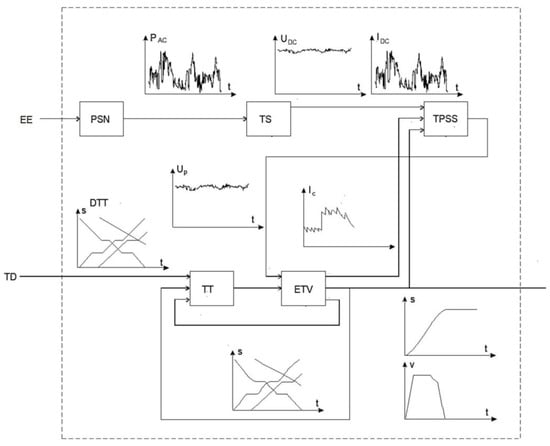
Figure 2.
Functional scheme of ETS system after decomposition into subsystems and presentation of exemplary time runs of input and output values (EE—electrical energy, TT—timetable, DTT—demanded timetable, RTT—actual (resulted timetable), TD—transport demand, T—transport output, IC—ETV current, Up-voltage in a catenary, IDC—TS current, UDC—voltage at TS busbar, PAC—power taken by TS from PSN), s—position of a train, v—speed, t—time (based on [47]).
The problem of energy consumption optimization may be translated into system analysis based on criteria, such as specific energy consumption, effectiveness of operational, maintenance, and investment spending, the share of these costs in global financial indicators of the railway line, and their relation to income from traffic service. Energy costs are easy to separate, but the share of traction power supply department in total railway income is difficult to attribute and may be assessed according to the share in global capital expenditure.
The observed trend is decreasing traffic volumes and power consumption with power cost increases more than the inflation rate. Hence, operational costs of railways can be reduced by power savings.
A special multi-criteria methodology was derived for a feasibility study concerning electrified transport systems. The methodology incorporates technical requirements, standards, per-unit energy, capital spending, and operational and maintenance costs to assess global and partial profitability. The methodology is based on the following components:
- -
- Find a solution for technical structure of AC and DC power supply for a defined traffic flow and organization;
- -
- Calculate, according to the defined criteria, railway traffic capacity for the pre-set structure of power supply and describe the requirements for the organization of traffic;
- -
- Verify, with a view to energy consumption, the assumed organization of traffic volumes, assign it to trains categories and timetables.
Operational study and system analysis provide a foundation for identifying adequate measures, taking into account:
- -
- Usefulness of the solution;
- -
- Multivariant options;
- -
- Mathematical description of technical and economic problems of energy use;
- -
- Assessment of the advantages and drawbacks of particular options taking into account uncertainties and risks.
The analysis and simulation studies have shown that the main measures leading to the electrical energy rationalization may be structured around two groups:
- Long-term measures:
- -
- Upgrade of AC and DC power supply networks;
- -
- Putting into service a new type of rolling stock;
- -
- Track upgrade (proper profile, increased speed limits).
This area results from previous negligence and the application of ineffective solutions.
- Short-term (low-investment) measures are based on organizational changes in:
- -
- Traffic;
- -
- Energy supply (lower tariffs, special agreements, time-zone tariffs, etc.).
Energy consumption and losses are determined not only by technical factors (technical solutions of equipment and energy consumption by rolling stock) but also organizational aspects and process engineering. Lower power consumption by traction can be achieved by:
- Optimized vehicle movement, timetable, sequences of trains, including by application of automatic control and management;
- Proper matching of locomotives and trains (power, speed, weight, distance, route profile).
Reduction in traction losses may be achieved by:
- Applying proper power supply patterns and systems;
- Energy saving equipment;
- Spreading peak loads during longer periods to limit excessive rush load and make traction load more uniform, increase reliability and availability of power delivery systems.
In analyzing the problem of efficient ERL operation, not only technical but also financial and economic aspects of the problem should be considered. Final assessments, in order to be complex and credible, have to consider all the above-mentioned aspects as the improvement of traffic service and competition between different means of transport. This must result in increased energy consumption. On the other hand, measures to reduce energy consumption may be not worth the outcome. Rationalization of energy usage should be treated as a process of reducing global energy consumption and power demand, operational, maintenance, and capital costs in energy supply. Due to significant restrictions and conditioning, rationalization of energy consumption is defined as:
- -
- Aim at reduction in energy consumption;
- -
- Reduction in costs of energy and demanded power;
- -
- Defining the rational level of required investments in power supply.
Rationalization of electric power should be, according to the authors of this paper, understood as follows:
- -
- Where possible, reasonable and economically justified reduction in energy consumption, having in mind traffic demand and quality of service;
- -
- Reduction in the cost of energy whenever and wherever possible.
The goal of minimized power consumption, if treated as an independent and overriding goal, may lead to adopting technical standards that require unjustifiably high capital spending. A reasonable solution would be a compromise between energy consumption and its costs, capital and operational costs, and income.
Similarly, when minimization of losses is assumed to be an overriding objective, the required “ideal” technical solution can be reached at a very high capital cost. Due to such financial aspects, it is reasonable to accept the compromise solution.
Energy consumption for traction is strictly dependent on the traffic and the type of service, specifically the following parameters: speed (maximum and average), power demand (maximum and average), weight, distances between stops, and density of trains (during rush hours, average per day). Traffic service, creating the income for the railway operator, is performed by some categories of trains, of which some are more, while others are less profitable. In general, freight traffic makes a profit; qualified passenger trains are close to covering operating costs, while ordinary passenger traffic has to be subsidized. From the point of view of energy consumption and income, the more energy a train consumes (as suburban trains), the less the income (local trains are co-financed by local authorities).
For assessing the “reasonableness” and “energy-saving quality” of the operation of a railway line, the ratio of the actual costs of energy used to assumed minimal energy used costs (“ideal solution”) may be applied.
When preparing the study of modernization options of ERL, one must work out the scenario of strategic activities in order to introduce solutions including modern technological and technical measures according to the international bodies—(International Union of Railways (UIC), European Innovation Council (IEC), European Commission (EC)), recommendations and standards. As partial tasks within the assumed strategy, the following may be mentioned:
- Interoperability;
- Reliability;
- Minimization of investment and operational costs;
- Improving safety by implementation of ETCS (European Train Control System);
- ERTMS (European Rail Traffic Management System);
- Reducing negative impacts of railway lines on infrastructure and the environment.
Within the framework of EC legislation, the Trans-European Railway Network is created, and all the railway operators will have the right to access the railway infrastructure. The unification of standards [48] is required for the power supply of different AC and DC systems delivering electrical energy to multi-system locomotives. To meet these requirements, effective and reliable electric traction power supply systems have to be assured. These tasks are being performed with wide application of specific modeling and simulation methods of analysis and design process. Multi-criteria feasibility studies and projects need to be developed for defining the required area of modernization and investment with financial and economic Cost–Benefit Analysis (CBA), with which the optimum can be found according to the adopted criteria.
The voltage at the pantograph Up is a significant parameter having influence on the power delivered by the traction drive system and its efficiency ηp. For different conditions of operation for the delivered: mechanical power Pm, electrical power Pel depend on the locomotive voltage Up and current Ic acc. to the following formulae:
where: Fp, vp—traction force and speed of the locomotive.
Pm = Fp vp
Pel = Up Ic
Pmech/Pel = ηp
Putting into service high power trains will be effective provided that the power supply system has enough capacity to deliver enough power of good quality (voltage) to them [42,44,49], as traction motors (Figure 2) and vehicles characteristics (Figure 3 and Figure 4) depend on the voltage in the catenary and available speed (Figure 5).
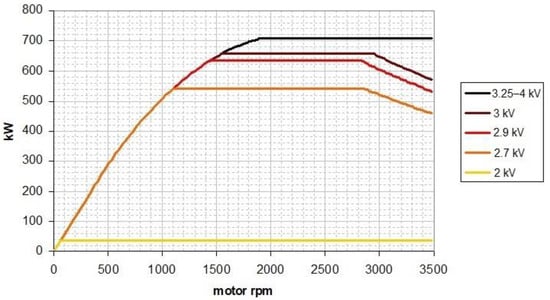
Figure 3.
Dependence between power developed by a traction motor of ED250 train on its rotational speed and voltage at pantograph. Source: Alstom.
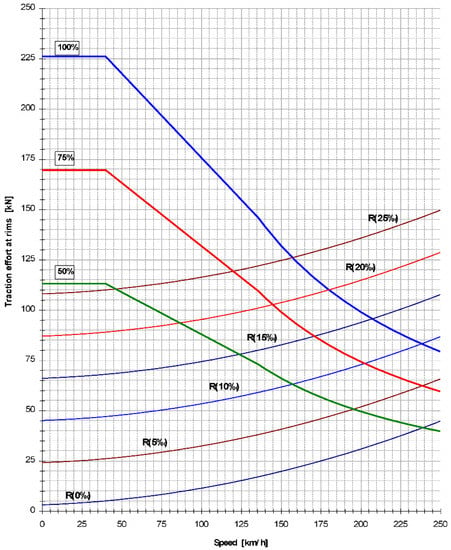
Figure 4.
Traction effort [kN] and resistance R[kN] as a function of ETR 610 (ED250) train speed at 100%, 75%, and 50% power available. Source: Alstom.
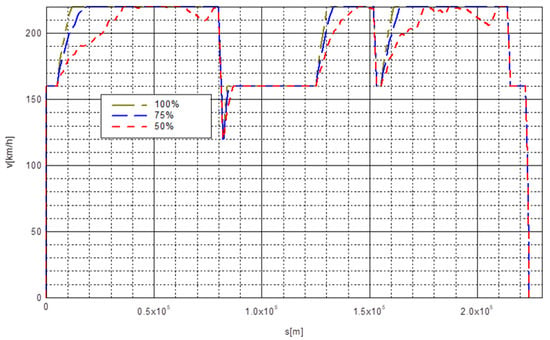
Figure 5.
Influence of available power (100%, 75%, and 50%) on speed changes of ETR 610 (ED250) train on route Grodzisk Maz.–Zawiercie with set speed limit sections. Source: Own study—Results of simulations.
Figure 6 shows traction effort F[kN] and resistance R[kN] as a function of speed v and voltage Up for BoBo 6 MW locomotive with 10 passenger coaches—exemple for simulation.

Figure 6.
Traction effort F[kN] and resistance R[kN] as a function of speed v and voltage Up for BoBo 6 MW locomotive with 10 passenger coaches (exemplary characteristic assumed by the authors for simulations). Source: Own study.
5. ED250 (Pendolino)—The First High-Speed Trains in Poland
5.1. Assumptions of the High-Speed Train Purchase Project in Poland
The decision to purchase high-speed trains was made as part of preparing a program for the construction and commissioning of high-speed rail in Poland [50]. These trains were put into operation on the modernized lines from Warsaw to Krakow and Katowice and from Warsaw to Gdańsk. It was assumed that the maximum speed on the CMK-southern line from Warsaw to Krakow and Katowice would increase up to 250 km/h, and on certain length of the line from Warsaw to Gdańsk to 200 km/h. The new trains were to form a new category called EIP (Express Intercity Premium), offering the highest quality in terms of comfort and travel time. PKP Intercity’s strategy also assumed transport by trains of the following categories:
- EIC (Express Intercity)—a wagon train run by a locomotive; assumed V max 160 km/h;
- IC (Intercity)—new emu and new or modernized coaches, assumed V max 160 km/h;
- TLK—conventional coaches.
The investment project “Purchase of railway passenger rolling stock for long-distance connections” has been entered on the List of Individual Projects for the Infrastructure and Environment Program [51].
A multi-month competitive dialogue with five rolling stock manufacturers concluded with the submission of only one tender for the delivery of 20 vehicles. On 30 May 2011, an agreement was signed between Alstom and PKP Intercity (PKP IC). In addition to the delivery of 20 trains (at a price of EUR 20 million each; with EU funding), it included the maintenance of trains-the level of 1, 2, 3, and 4 for 17 years (cost of EUR 1.95 per 1 km) and the training of PKP IC employees. The first train delivered in 2013 was tested for certification at a speed of 250 km/h + 10% (275 km/h). On November 24, a speed of 293 km/h was reached on the CMK section between Góra Włodowska and Psary, which was:
- Speed record in the Polish network;
- World record for 3kV DC traction system;
- Record for Pendolino trains family.
After completing the tests, along with the new timetable, in December 2014, regular services of Polish high-speed trains began.
5.2. Characteristics of ED250
ED250 trains are electric multiple units consisting of seven wagons connected in a semi-permanent way. These trains based on the ETR610 Pendolino design are not equipped with a tilting mechanism. The setup can operate at different voltages. Their technical parameters are specified in Table 1, traction characteristics in Figure 3 and Figure 4. The passenger compartments, the driver’s cab and the train manager’s compartment, are equipped with carefully designed furnishings to ensure maximum ergonomics in operation.

Table 1.
ED250 technical parameters.
5.3. Offer Development
The assumptions of the project “Purchase of railway passenger rolling stock for long-distance services-Stage I” related to vehicles to support the following lines:
- Warsaw–Gdynia (with intermediate stations: Sopot, Gdańsk Oliwa, Gdańsk Wrzeszcz, Gdańsk Główny, Tczew, Malbork, Iława, Warszawa Wschodnia);
- Warsaw–Krakow (with intermediate stations: Warszawa Zachodnia);
- Warsaw–Katowice (with intermediate stations Warszawa Zachodnia, Sosnowiec Główny, Zawiercie) [51].
ED250 trainsets went into regular operation in Poland on 14 December 2014. Since 2014, EIP train routes, implemented with ED250 combined trains, have undergone many changes resulting from the development of marketing concepts—see Table 2 and Figure 7.

Table 2.
EIP train routes.
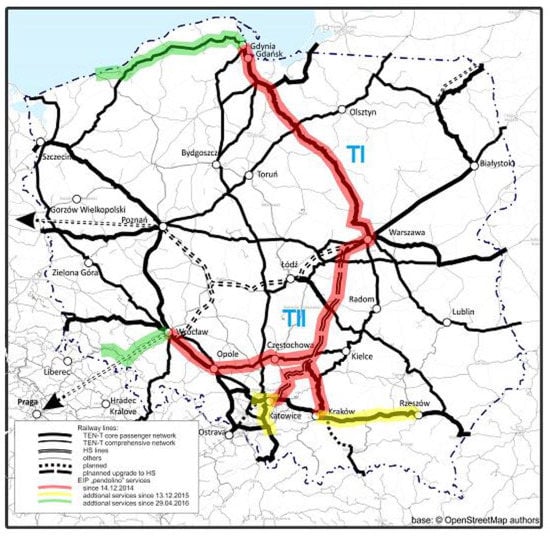
Figure 7.
EIP (ED250) services since 14 December 2014. Source: T. Bużałek, based on: © OpenStreetMap authors.
During the period of validity of the EIP offer, changes in their operation were sometimes introduced to the timetable due to planned modernization works:
- On 13 March 2016, certain connections to Wrocław were temporarily redirected from line No. 4 to line No. 1, which extended travel time and involved a stop at the Częstochowa Stradom station instead of Częstochowa The reason for the change was maintenance works on line 4 [53];
- On the 6–11 August 2016, due to maintenance works at the Biała Rawska station, the movement of trains on the Grodzisk Mazowiecki–Idzikowice section was completely suspended, and trains were directed to detour routes: to Kraków via Koluszki, Tomaszów Mazowiecki and Idzikowice, and to Katowice via Skierniewice, Koluszki, and Częstochowa [54];
- From 10 July to 10 August 2017 on the CMK section Opoczno Południe–Włoszczowa Północ/Knapówka there was a round-the-clock both-way closure, as a result of which most trains ran through Skierniewice and Częstochowa. In addition, two EIP Warsaw–Jelenia Góra trains ran through the Łódź Widzew station [55].
The most significant change in the operation of EIP trains was in March 2020 when, due to COVID-19 developments, the operation of these trains was suspended [56].
Currently, according to the information of 15 May 2022, the Warsaw East–Jelenia Góra section is out of service. See Table 3 for a list of relationships in service and route lengths.

Table 3.
List of supported routes with length.
In Table 4 for you can find ED250 average daily mileage for 2015–2020 period.

Table 4.
Average daily mileage.
6. Energy Efficiency and Environmental Outcomes of ED250 Trains—A Case Study
Until the introduction of the ED250 trains, traffic at a speed of Vmax of 200 km/h was possible by trains composed of wagons and a 6 MW locomotive. Therefore, it was interesting to analyze to what extent the replacement of locomotive trains with ED250 trains achieved not only qualitative, but also energy and environmental effects in line with the Green Deal policy. For comparative purposes, simulations of the movement were carried out for:
- -
- -
 Table 5. Assumed parameters of a passenger train PAS with a BoBo locomotive.
Table 5. Assumed parameters of a passenger train PAS with a BoBo locomotive.
Simulation analyses of the movement of both trains were carried out for two lines on which ED250 trains are in service.
Figure 6 shows the vertical profile of the TI (Figure 8a) and TII (Figure 8b) routes, respectively, while Figure 9 shows the speed profile for TI line.

Figure 8.
Vertical profile for lines: TI (a) and TII (b). Source: developed by the authors based on available data.

Figure 9.
Trains speed profile on TI line (a) direction W-Gd and (b) direction Gd-W. Source: developed by the authors-results of simulations.
In Figure 10, current waveforms drawn from the 3 kV DC network for ED250 and PAS trains on the TI route in the direction Warsaw–Gdańsk. The parameters of the travel are presented in Table 6.
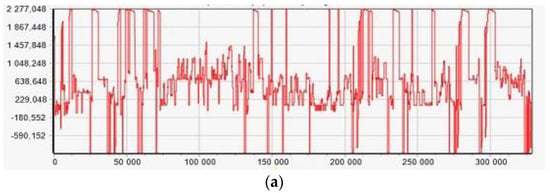

Figure 10.
Current drawn by trains on the TI route-direction of movement W-Gd (a) ED250 and (b) PAS. Source: developed by the authors-results of simulations.

Table 6.
Results of simulations trains ED250 and PAS and calculated energy and emission parameters.
Figure 11 shows speed profile for line TII, while Figure 12 current waveforms drawn from the 3 kV DC network for ED250 (Figure 12a) and PAS (Figure 12b) trains on the TII route in the direction GM-Z. The parameters of the travel are presented in Table 6.

Figure 11.
Route train speed profile of TII line (a) direction GM-Z and (b) direction Z-GM. Source: developed by the authors-simulation results.
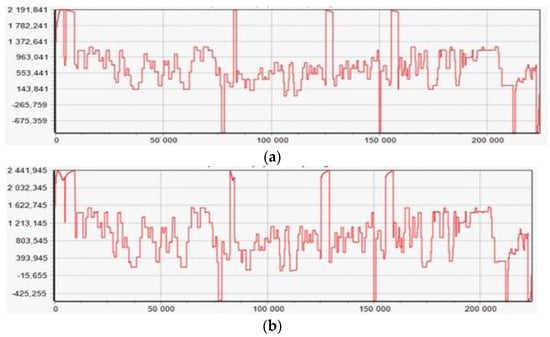
Figure 12.
Current drawn by trains on the route TII-direction GM-Z (a) ED250 and (b) PAS. Source: developed by the authors-simulation results.
The simulation results and comparison of traction and motion parameters are summarized in Table 6 below.
The results presented in Table 6 are comparable to those presented in literature [24,26,32,42,57], which supports the validity of the presented results and makes another positive case for the ED250 project compared to conventional locomotive trains.
A comparison of specific energy consumption for traction per ton km between the two types of trains indicates lower consumption of nearly 3.5 Wh/t for ED250 over PAS trains on the TI route and about 3 Wh/tkm on the TII route. Figure 13 compares the specific energy consumption for traction used by ED250 and PAS trains. Calculations of energy consumption for five years of operation of ED250 trains indicates savings in energy consumption due to ED250 trains service (average specific energy consumptions for routes TI and TII were adopted).
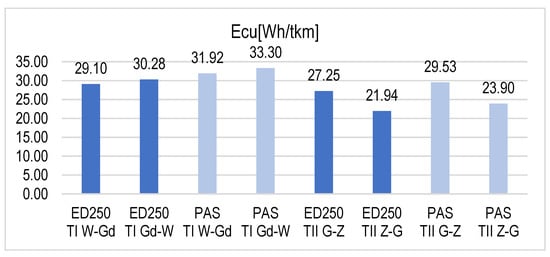
Figure 13.
Comparison of specific energy consumption for traction. Source: developed by the authors.
A comparison of energy consumption, with 100% and 60% seats in the train occupied, indicates that the ED250 train is more environmentally friendly. On both routes and in both directions, there is a difference, on the TI route about 10 kWh/(1000 pas km) with 60% and about 6 kWh/(1000 paskm) with 100% occupied seats, and on the TII route when the train is 60% occupied: 9 kWh/(1000 paskm) in the direction of Grodzisk–Zawiercie and 7 kWh/(1000 paskm) in the direction Zawiercie–Grodzisk. Figure 14 shows a comparison of the energy consumption for the ED250 and PAS train, which is resulted from higher motion resistances R of PAS train (Figure 6) when compared with the ED250 train (Figure 4) and, respectively, higher current taken by the PAS train taken during travel (Figure 12b) comparing with the ED250 train (Figure 12a).
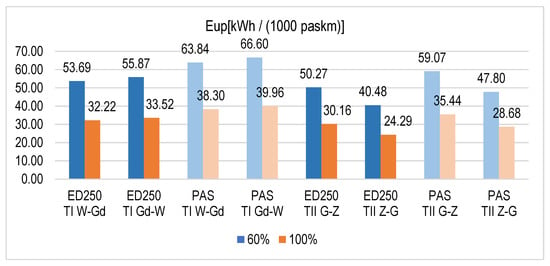
Figure 14.
Comparison the specific energy consumption Eup per 1000 paskm (assumed 100% and 60% nominal load). Source: developed by the authors.
A comparison of CO2 emissions for both types of trains indicates, as a consequence of lower energy consumption, lower emissions from high-speed trains compared to locomotive-driven trains, which is supported by studies relating to the railways of other countries [42,49,58]. On the TI Gdańsk–Warsaw route it is 0.0044 t/1000 paskm, and on the TII Grodzisk–Zawiercie route—0.0038 t/1000 paskm. The results for both directions of these routes are presented in Figure 15. As electrical power costs are burdened with CO2 emission fee (EU ETS), which has been increasing significantly in last years (Figure 1), it is worthwhile to calculate how a reduction in CO2 emission by ED250 influenced the reduction in CO2 emission and savings in EU ETS costs due to ED250 service within the 2015–2020 period with forecast for 2022 (Figure 16).
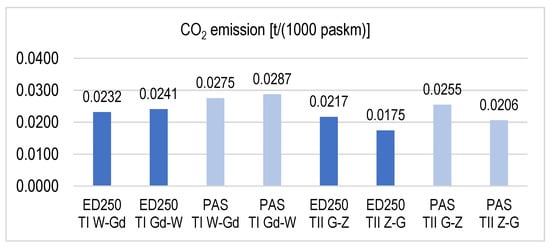
Figure 15.
Comparison of specific CO2 emissions [t/(1000 paskm)] for ED250 and locomotive train. Source: developed by the authors.
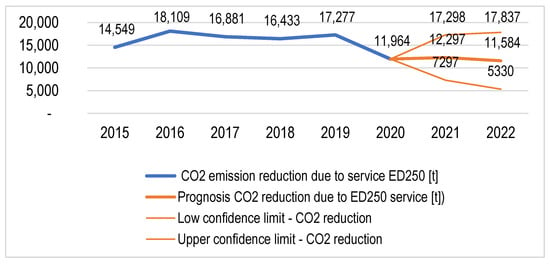
Figure 16.
CO2 emission reduction (2015–2020) and forecast. Source: developed by the authors.
These reductions in the following years depended mainly on the number of kilometers traveled, resulting from infrastructural upgrade works. The significant decrease in carbon dioxide emissions observed in 2020, shown in Figure 16 and Figure 17, is due to restrictions on the operation of trains during the most severe period of COVID-19 crisis [56]. Total CO2 reductions over the five-year period was 95,212 tons, and the total EU ETS cost savings amounted to EUR 1,282,913.
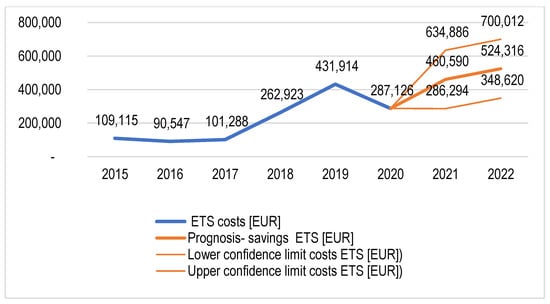
Figure 17.
EU ETS savings (2015–2020) and forecast EU ETS savings. Source: developed by the authors.
The presented analysis has confirmed that the decision to put into service high-speed trains in Poland was not only a breakthrough for the railway service market in Poland, but also had positive outcomes for energy consumption and environment in Poland.
Since 2015, ED250 trains allowed to reduce over 95,000 tons of CO2 emissions, which cost, measured by EU ETS prices, was estimated EUR 1.28 million. Assuming 30 years of service, this amount is estimated to be more than EUR 6 million.
The use of vehicles with ED250 parameters instead of locomotive trains in the Polish network would contribute to the achievement of transport objectives set out in the European Green Deal.
In addition, it is worthwhile to mention Poland’s notification to the TEN-T comprehensive network of sections of the HSR with an assumed maximum speed of 350 km/h:
- -
- Warszawa–Łódź-Kalisz 230 km;
- -
- Kalisz–Poznań 120 km;
- -
- Kalisz–Wrocław 100 km;
- -
- Poznań–German border (to Berlin) 120 km;
Wroclaw–border with the Czech Republic (to Prague) 150 km, (maximum speed 250–350 km/h depending on topographic conditions).
It is obvious that there is a significant potential of Polish railways in terms of reducing emissions from transport. The construction of 720 km of planned high-speed lines (HSL) will improve territorial cohesion and transport accessibility while limiting adverse impacts on the environment in comparison not only with road and air transport, but with conventional trains. The analysis shows environmental advantages of high-speed rail transport when specially designed modern trains are put into service instead of locomotive trains.
Due to the fact that EU ETS costs (Figure 1) and energy prices have increased steeply (in Poland from EUR 40/1 MWh in January 2018 to EUR 180/1 MWh in January 2022 [59]), the prognosis for future energy costs are not optimistic. However, it makes a strong case for taking any measures available to transform energy generation from fossil fuels to RES for achieving CO2 emission and energy consumption reduction targets and savings. Obviously, the power and costs saved by putting into service ED250 trains instead of locomotive ones is not very high, but is another step in addition to many others taken in Poland to reduce environmental burden and costs and being part of wider environmental policy.
7. Conclusions
The article presents results of analysis of energy efficiency and effectiveness in CO2 reduction due to putting ED250 trains (Pendolino platform) into service in the railway network in Poland. Since 2014, ED250 trains allowed Poland to reach maximum service speed of 200 km/h on specially modernized 3 kV DC lines and became a breakthrough in recognition of railway transport by the public. The goal of this paper is only to present limited aspects (energy efficiency, environmental burden, etc.) of putting into service traction units with ED250 as an example of modern trains compared with locomotive trains previously used by Polish railway operators. The presented research employed simulation methods for running ED250 and equivalent locomotive passenger trains to compare parameters of service on main railway lines where ED250 trains are operating. This allowed us to compare energy efficiency of ED250 trains with the locomotive ones. Other benefits of the introduction of ED250 trains were assessed considering global and per-unit (per passenger km) energy consumption and CO2 emission reduction as stated in [7], which due to significant jump in EU ETS and energy prices is an important issue.
The conclusions from the research could support the policy of increasing speeds of trains and then win competition with road and air transport in such countries as Poland, where electrical energy generation based on coal power plants and road transport raise many problems, not only environmental ones (CO2 unitary emission in 2021 were 0.719 t/1 MWh of electric energy, much more than in other EU countries). The presented analysis could support decision-makers in taking into account environmental aspects when purchasing rolling stock and replacing the fleet of locomotive trains (owned by operators) with traction units. Of course, it is only one example among other activities undertaken and planned in Poland (mentioned in p. 2.) to reduce energy consumption by railway transport and increase the use of electricity generated from RES. This could make railway transport competitive enough to meet the main requirements of sustainable development pursued by societies as part of the EU Green Deal policy. Further analysis in this area could take into account the life-cost cycle (LCC), including the energy used and emissions resulting not only from service, but also from the construction and recycling of rolling stock.
Author Contributions
Conceptualization—A.P. and A.S.; Methodology—A.S.; Resources—A.P. and A.S.; Investigation—A.P.; Writing—Original Draft—A.P. and A.S.; Writing—Review and Editing—A.P.; Project administration—A.P.; Formal analysis—A.S.; Validation Application—A.S.; Supervision—A.S. All authors have read and agreed to the published version of the manuscript.
Funding
This research received no external funding.
Institutional Review Board Statement
Not applicable.
Informed Consent Statement
Not applicable.
Data Availability Statement
Not applicable.
Conflicts of Interest
The authors declare no conflict of interest.
Nomenclature
| AC | Alternating current |
| CBA | Cost–Benefit Analysis |
| CEEK | Center for Railway Energy Efficiency |
| DC | Direct Current |
| DTT | Demanded Timetable |
| Ec | Energy consumption for traction purposes only on a route |
| Ecu | Specific energy consumption for traction purposes per to km |
| Ecut | Specific energy consumption for traction purposes per train km |
| Ecrek | Energy consumption for traction purposes only with recuperation on the route |
| EC | European Commision |
| EE | Electrical energy |
| EIC | European Innovation Council |
| ERL | Electrified Railway Lines |
| ERTMS | European Rail Traffic Management System |
| ETCS | European Train Control System |
| ETS | Electrified Transport System |
| EU ETS | EU Emissions Trading System |
| EU | European Union |
| Eup | Energy consumption for traction per 1000 pas km |
| Fp | Traction force |
| GHG | Greenhouse Gas |
| Ic | ETV current |
| IDC | TS current |
| OECD | Organisation for Economic Cooperation and Development |
| PAC | Power taken by TS from PSN |
| Pel | Electric power taken by a train |
| Pmech | Mechanical power developed by a train |
| PKP S.A. | Polish State Railways |
| PKP Energetyka | Power supply company for railways in Poland |
| PKP PLK S.A. | Railway Infrastructure Manager |
| PPS | Purchasing Power Standards |
| RES | Renewable Energy Sources |
| RTT | Resulted time-tabe |
| TD | Transport demand |
| TEN-T | Trans-European Transport Network |
| TGV | High-Speed Train (in France) |
| TO | Transport output |
| TT | Timetable |
| UDC | Voltage at TS’s busbar |
| Up | Voltage in catenary (at ETV’s pantograph) |
| UIC | International Union of Railways |
| WKD | Warsaw Commuter Railway (in Poland) |
| Vp | Speed of the locomotive |
| vav | Average velocity without time of stops |
| vavs | The average velocity with time of stops |
| %RS | Savings in energy consumption due to recuperation |
References
- UN. Enviroment Programme Report of the Governing Council on the Work of Its Third Session; UN: New York, NY, USA, 1975. [Google Scholar]
- UN General Assembly. Rio Declaration on Environment and Development; UN General Assembly: New York, NY, USA, 1992; Volume I, pp. 1–5. [Google Scholar]
- UN. Agenda 21. Rio de Janerio. 1992. Available online: http://www.un.org/esa/sustdev/documents/agenda21/english/Agenda21.pdf (accessed on 12 September 2021).
- EC. Towards Sustainability. In A European Community Programme of Policy and Action in Relation to the Enviroment and Sustainable Development; EC: Bruxelles, Belgium, 1993. [Google Scholar]
- European Commission. A Sustainable Europe for a Better World. A European Union Strategy for Sustainable Development; European Commission: Bruxelles, Belgium, 2001; pp. 1–16. [Google Scholar]
- European Council. Review of the EU Sustainable Development Strategy (EU SDS)—Renewed Strategy. Annex 10117/06; European Council: Brussels, Belgium, 2006; pp. 1–29. [Google Scholar]
- Commission of the European Communities. A Sustainable Future for Transport: Towards an Integrated, Technology-Led and User Friendly System; Commission of the European Communities: Brussels, Belgium, 2009. [Google Scholar]
- European Commission. A European Strategy for Smart, Sustainable and Inclusive Growth; European Commission: Brussels, Belgium, 2020. [Google Scholar]
- EC. The European Green Deal; EC: Bruxelles, Belgium, 2019. [Google Scholar]
- Komisja Europejska. Strategia na Rzecz Zrównoważonej i Inteligentnej Mobilności—Europejski Transport na Drodze ku Przyszłości; Komisja Europejska: Bruksela, Belgium, 2020. [Google Scholar]
- OECD European Conference of Ministers of Transport. Assesment & Decision Making for Sustainable Transport; European Conference of Ministers of Transport: Paris, France, 2004. [Google Scholar] [CrossRef]
- Szeląg, A.; Lewandowski, M.; Maciołek, T. Od tramwaju do elektromobilności—140 lat rozwoju i 100 lat nauczania trakcji elektrycznej w Politechnice Warszawskiej. Prz. Elektrotechniczny 2020, 96, 213–224. [Google Scholar] [CrossRef]
- EU Carbon Permits. Trading Economics. 2022. Available online: https://tradingeconomics.com/commodity/carbon (accessed on 18 February 2022).
- CO2 Emission by Transport. EEA. 2017. Available online: https://www.eea.europa.eu/data-and-maps/indicators/transport-emissions-of-greenhouse-gases/transport-emissions-of-greenhouse-gases-12 (accessed on 18 February 2022).
- GUS. Raport 2020. Polska na Drodze Zrównoważonego Rozwoju’, Warszawa. 2020. Available online: https://raportsdg.stat.gov.pl/2020/cel13.html (accessed on 16 February 2022).
- Song, M.; Wu, N.; Wu, K. Energy Consumption and Energy Efficiency of the Transportation Sector in Shanghai. Sustainability 2014, 6, 702–717. [Google Scholar] [CrossRef] [Green Version]
- Baumeister, S. Replacing short-haul flights with land-based transportation modes to reduce greenhouse gas emissions: The case of Finland. J. Clean. Prod. 2019, 225, 262–269. [Google Scholar] [CrossRef]
- Dalkiç, G.; Balaban, O.; Tuydes-Yaman, H.; Celikkol-Kocak, T. An assessment of the CO2 emissions reduction in high speed rail lines: Two case studies from Turkey. J. Clean. Prod. 2017, 165, 746–761. [Google Scholar] [CrossRef]
- Sun, Y.-Y.; Lin, Z.-W. Move fast, travel slow: The influence of high-speed rail on tourism in Taiwan. J. Sustain. Tour. 2017, 26, 433–450. [Google Scholar] [CrossRef]
- Van Wee, B.; Brink, R.V.D.; Nijland, H. Environmental impacts of high-speed rail links in cost–benefit analyses: A case study of the Dutch Zuider Zee line. Transp. Res. Part D Transp. Environ. 2003, 8, 299–314. [Google Scholar] [CrossRef]
- Van Essen, H.; Bello, O.; Dings, J.; Brink, R.V.D. To Shift or not to Shift, That’s the Question: The Environmental Performance of the Principal Modes of Freight and Passenger Transport in the Policymaking Process; CE: Delft, The Netherlands, 2003. [Google Scholar]
- Huang, C.-H. Inventory of Energy Consumption and Greenhouse Gas Emissions in Transportation Sector—Developing Energy Efficiency Indicator and Modeling Energy Consumption for Transportation Sector; Institution of Transportation, Ministry of Transportation and Communications: Taipei, Taiwan, 2011.
- Robertson, S. The potential mitigation of CO2 emissions via modal substitution of high-speed rail for short-haul air travel from a life cycle perspective—An Australian case study. Transp. Res. Part D Transp. Environ. 2016, 46, 365–380. [Google Scholar] [CrossRef]
- Åkerman, J. The role of high-speed rail in mitigating climate change—The Swedish case Europabanan from a life cycle perspective. Transp. Res. Part D Transp. Environ. 2011, 16, 208–217. [Google Scholar] [CrossRef]
- Chen, P.; Lu, Y.; Wan, Y.; Zhang, A. Assessing carbon dioxide emissions of high-speed rail: The case of Beijing-Shanghai corridor. Transp. Res. Part D Transp. Environ. 2021, 97, 102949. [Google Scholar] [CrossRef]
- Chester, M.; Horvath, A. High-speed rail with emerging automobiles and aircraft can reduce environmental impacts in California’s future. Environ. Res. Lett. 2012, 7, 034012. [Google Scholar] [CrossRef]
- Tang, Z.; Mei, Z.; Zou, J. Does the Opening of High-Speed Railway Lines Reduce the Carbon Intensity of China’s Resource-Based Cities? Energies 2021, 14, 4648. [Google Scholar] [CrossRef]
- Jiang, C.; Wan, Y.; Yang, H.; Zhang, A. Impacts of high-speed rail projects on CO2 emissions due to modal interactions: A review. Transp. Res. Part D Transp. Environ. 2021, 100, 103081. [Google Scholar] [CrossRef]
- Cornet, Y.; Dudley, G.; Banister, D. High Speed Rail: Implications for carbon emissions and biodiversity. Case Stud. Transp. Policy 2018, 6, 376–390. [Google Scholar] [CrossRef] [Green Version]
- Amjad, S.; Rudramoorthy, R.; Neelakrishnan, S. Assessment of petroleum saving and greenhouse gas emission reduction from two-wheeler segment: 2011–2021. Transp. Res. Part D Transp. Environ. 2011, 16, 265–269. [Google Scholar] [CrossRef]
- Smith, R.; Shahidinejad, S.; Blair, D.; Bibeau, E. Characterization of urban commuter driving profiles to optimize battery size in light-duty plug-in electric vehicles. Transp. Res. Part D Transp. Environ. 2011, 16, 218–224. [Google Scholar] [CrossRef]
- Merchan, A.L.; Belboom, S.; Leonard, A. Life cycle assessment of rail freight transport in Belgium. Clean Technol. Environ. Policy 2020, 22, 1109–1131. [Google Scholar] [CrossRef]
- Mabit, S.L.; Fosgerau, M. Demand for alternative-fuel vehicles when registration taxes are high. Transp. Res. Part D Transp. Environ. 2011, 16, 225–231. [Google Scholar] [CrossRef]
- Maghelal, P. Investigating the relationships among rising fuel prices, increased transit ridership, and CO2 emissions. Transp. Res. Part D Transp. Environ. 2011, 16, 232–235. [Google Scholar] [CrossRef]
- Cariou, P. Is slow steaming a sustainable means of reducing CO2 emissions from container shipping? Transp. Res. Part D Transp. Environ. 2011, 16, 260–264. [Google Scholar] [CrossRef]
- Radu, P.V.; Szelag, A.; Steczek, M. On-Board Energy Storage Devices with Supercapacitors for Metro Trains—Case Study Analysis of Application Effectiveness. Energies 2019, 12, 1291. [Google Scholar] [CrossRef] [Green Version]
- Radu, P.V.; Lewandowski, M.; Szelag, A. On-Board and Wayside Energy Storage Devices Applications in Urban Transport Systems—Case Study Analysis for Power Applications. Energies 2020, 13, 2013. [Google Scholar] [CrossRef] [Green Version]
- Carbon-Neutral Flying. Available online: https://www.lufthansa.com/es/en/offset-flight (accessed on 12 February 2022).
- KPGM Advisory Sp. z Ograniczoną Odpowiedzialnością Sp. k. We Energize Polish Rail. Corporate Responsability Report 2020—PKP Energetyka Capital Group, Warsaw. 2020. Available online: https://www.pkpenergetyka.pl/O-PKP-Energetyka/Spoleczna-odpowiedzialnosc/Raporty-spoleczne/PL/PKP_Energetyka_-_Sustainability_Report_2020_EN.pdf (accessed on 8 February 2022).
- EU. Regulation (EU) No 1315/2013 of the European Parliament and of the Council of 11 December 2013 on Union Guidelines for the Development of the Trans-European Transport Network and Repealing Decision No 661/2010/EU; Consolided Version; EU: Bruxelles, Belgium, 2013; pp. 1–21. [Google Scholar]
- EU. Regulation (EU) No 1316/2013 of the European Parliament and of the Council of 11 December 2013 Establishing the Connecting Europe Facility, Amending Regulation (EU) No 913/2010 and Repealing Regulations (EC) No 680/2007 and (EC) No 67/2010; EU: Bruxelles, Belgium, 2013; Volume 2013, pp. 129–171. [Google Scholar]
- Renfe. High Speed Trains and Energy Efficiency; Renfe: Madrid, Spain, 2007. [Google Scholar]
- Banar, M.; Özdemir, A. An evaluation of railway passenger transport in Turkey using life cycle assessment and life cycle cost methods. Transp. Res. Part D Transp. Environ. 2015, 41, 88–105. [Google Scholar] [CrossRef]
- Alnuman, H.; Gladwin, D.; Foster, M. Electrical Modelling of a DC Railway System with Multiple Trains. Energies 2018, 11, 3211. [Google Scholar] [CrossRef] [Green Version]
- Pilo, E.; Rouco, A.; Fernandez, A. A Simulation Tool for the Design of the Electrical Supply System of High-Speed Railway Lines. In Proceedings of the 2000 Power Engineering Society Summer Meeting (Cat. No.00CH37134), Seattle, WA, USA, 16–20 July 2000. [Google Scholar] [CrossRef]
- Arboleya, P.; Mayet, C.; Mohamed, B.; Aguado, J.A.; de la Torre, S. A review of railway feeding infrastructures: Mathematical models for planning and operation. eTransportation 2020, 5, 100063. [Google Scholar] [CrossRef]
- Szeląg, A.; Maciołek, T. A 3 kV DC electric traction system modernisation for increased speed and trains power demand-problems of analysis and synthesis. Prz. Elektrotechniczny 2013, 89, 21–28. [Google Scholar]
- European Commission. Commission Implementing Regulation (EU) 2019/776 of 16 May 2019 Amending Commission Regulations (EU) No 321/2013, (EU) No 1299/2014, (EU) No 1301/2014, (EU) No 1302/2014, (EU) No 1303/2014 and (EU) 2016/919 and Commission Implementing Decision 2011/665/EU; European Commission: Brussels, Belgium, 2019; pp. 108–311. [Google Scholar]
- UIC. Railway Specific Environmental Performance Indicators. In Leaflet 330; UIC: Paris, France, 2008; pp. 1–48. [Google Scholar]
- Uchwała Nr 276/2008 Rady Ministrów z Dnia 19 Grudnia 2008 r. w Sprawie Przyjęcia Strategii Ponadregionalnej Programu Budowy i Uruchomienia Przewozów Kolejami Dużych Prędkości w Polsce; Ministerstwo Infrastruktury: Warszawa, Poland, 2008. Available online: www.mi.gov.pl (accessed on 14 March 2009).
- CUPT. Projekt Indywidualny: Zakup Kolejowego Taboru Pasażerskiego do Obsługi Połączeń Dalekobieżnych—Etap I. CUPT. 2011. Available online: www.cupt.gov.pl/archiwum/indexc68c.html?id=1025 (accessed on 15 April 2021).
- PKP Time-Table: 2014/2015, 2015/2016, 2016/2017, 2017/2018, 2018/2019, 2019/2020. PKP PLK S.A. Available online: https://portalpasazera.pl/Tablice (accessed on 8 December 2019).
- Pendolino Pojedzie Wiedenką do Wrocławia. Kurier Kolejowy. 2016. Available online: https://kurier-kolejowy.pl/aktualnosci/27396/pendolino-pojedzie--wiedenka--do-wroclawia.html (accessed on 15 March 2021).
- Szybkie Prace na CMK. Kurier Kolejowy. 2016. Available online: https://kurier-kolejowy.pl/aktualnosci/28408/szybkie-prace-na-cmk--by-podroze-byly-krotsze.html (accessed on 15 March 2021).
- ‘Czasowe Zmiany na CMK’. Rynek Kolejowy. 2017. Available online: https://www.rynek-kolejowy.pl/wiadomosci/czasowe-zmiany-na-cmk-82465.html (accessed on 15 March 2021).
- Pomykała, A. Polish Regional and Long-Distance Railway Transport during the COVID-19 Pandemic. Probl. Kolejnictwa Railw. Rep. 2021, 65, 185–194. [Google Scholar] [CrossRef]
- Rungskunroch, P.; Shen, Z.-J.; Kaewunruen, S. Benchmarking environmental and economic impacts from the HSR networks considering life cycle perspectives. Environ. Impact Assess. Rev. 2021, 90, 106608. [Google Scholar] [CrossRef]
- UIC High Speed Department. High Speed Railway System Implementation Handbook-Leaflet; UIC High Speed Department: Paris, France, 2012; p. 2. [Google Scholar]
- Wysokienapiecie.pl. 2021. Available online: https://wysokienapiecie.pl/41743-ceny-pradu-w-polsce-niemal-najnizsze-w-europie/ (accessed on 13 February 2022).
Publisher’s Note: MDPI stays neutral with regard to jurisdictional claims in published maps and institutional affiliations. |
© 2022 by the authors. Licensee MDPI, Basel, Switzerland. This article is an open access article distributed under the terms and conditions of the Creative Commons Attribution (CC BY) license (https://creativecommons.org/licenses/by/4.0/).